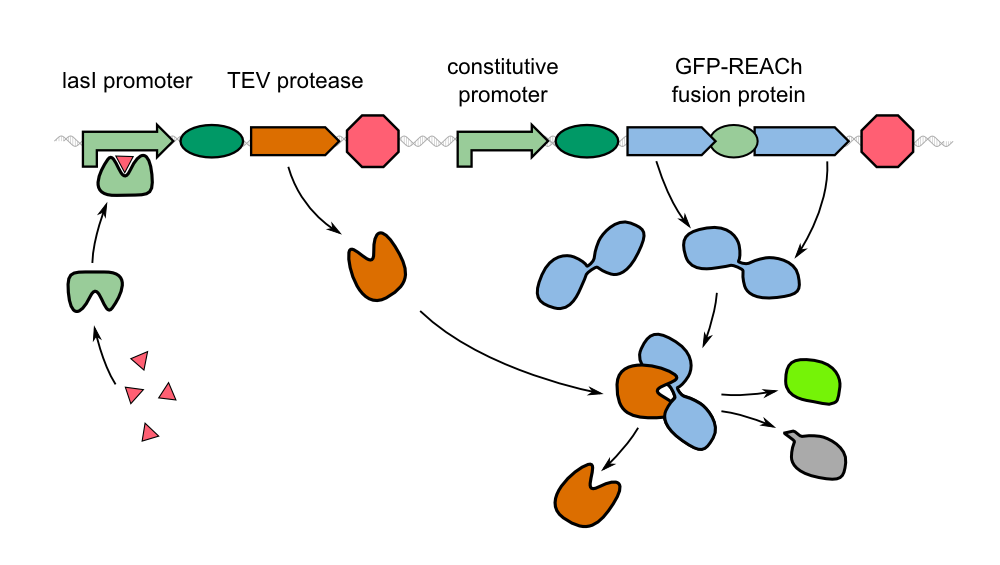Team:Aachen/Project/2D Biosensor
From 2014.igem.org
(→Principle of Operation) |
(→A Novel Molecular Approach) |
||
| Line 21: | Line 21: | ||
As a reporter gene, we use '''GFP'''. However, expression of GFP is not simply controlled through the LasI promoter activity in our approach. Instead, our sensor cells contain genes for a constitutively expressed fusion protein consisting of GFP and a dark quencher, and an '''HSL-inducible protease'''. We use the REACh protein as dark quencher for GFP and the TEV protease to cleave the complex; [https://2014.igem.org/Team:Aachen/Project/FRET_Reporter here] you can read more about the REACh construct and the TEV protease. | As a reporter gene, we use '''GFP'''. However, expression of GFP is not simply controlled through the LasI promoter activity in our approach. Instead, our sensor cells contain genes for a constitutively expressed fusion protein consisting of GFP and a dark quencher, and an '''HSL-inducible protease'''. We use the REACh protein as dark quencher for GFP and the TEV protease to cleave the complex; [https://2014.igem.org/Team:Aachen/Project/FRET_Reporter here] you can read more about the REACh construct and the TEV protease. | ||
| - | {{Team:Aachen/Figure|Aachen_REACh_approach.png|title=Our novel biosensor approach|subtitle=Expression of the TEV protease is induced by HSL. The protease cleaves the GFP-REACh fusion protein to elecit a fluorescence response.|width= | + | {{Team:Aachen/Figure|Aachen_REACh_approach.png|title=Our novel biosensor approach|subtitle=Expression of the TEV protease is induced by HSL. The protease cleaves the GFP-REACh fusion protein to elecit a fluorescence response.|width=500px}} |
When ''P. aeruginosa cells'' are stuck on our agar chip and come close to our sensor cells, the latter take up the HSL molecules secreted by the pathogens. Inside the sensor cells, the autoinducer binds to the LasR gene product and activate the expression of the TEV protease. The protease then cleaves the GFP-REACh construct. When '''illuminated with light of 480 nm''', the excitation wavelenght of GFP, our sensor cells in the vicinity of ''P. aeruginosa'' give a '''fluorescence signal'''. On the other hand, sensor cells that were not anywhere close to the pathogens do not express the protease. Therefore, the GFP will still be attached to the dark quencher in these cells, and no fluorescence is produced. | When ''P. aeruginosa cells'' are stuck on our agar chip and come close to our sensor cells, the latter take up the HSL molecules secreted by the pathogens. Inside the sensor cells, the autoinducer binds to the LasR gene product and activate the expression of the TEV protease. The protease then cleaves the GFP-REACh construct. When '''illuminated with light of 480 nm''', the excitation wavelenght of GFP, our sensor cells in the vicinity of ''P. aeruginosa'' give a '''fluorescence signal'''. On the other hand, sensor cells that were not anywhere close to the pathogens do not express the protease. Therefore, the GFP will still be attached to the dark quencher in these cells, and no fluorescence is produced. | ||
Revision as of 15:09, 10 October 2014
|
|
 "
"
